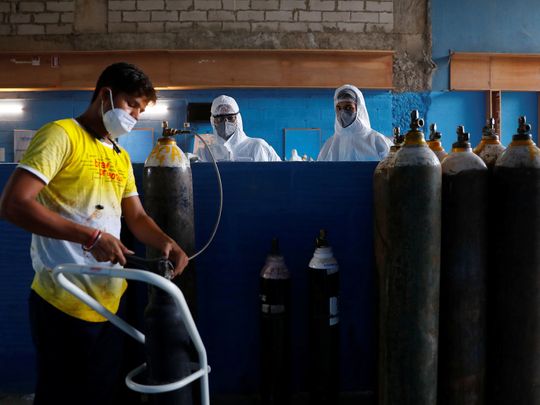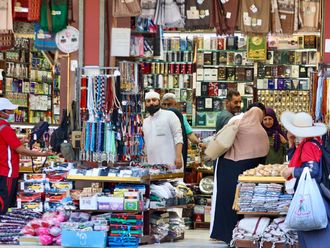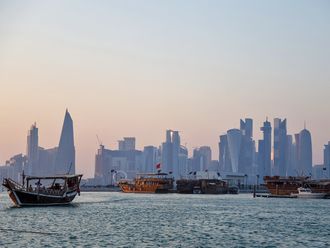
New Delhi: When the head of a hospital in a suburb of Mumbai called her oxygen supplier earlier this month, he had disturbing news: he couldn’t meet the full order. Demand for oxygen in the region was just too high as health facilities struggled to keep pace with rising coronavirus cases.
So the hospital chief executive Vaishali Jadhav made the decision that no medical professional wants to make. She began turning away new patients to make sure the hospital could care for existing ones. She wasn’t the only one scrambling to grapple with the unprecedented shortage in India for medical oxygen, a crucial component in treating COVID-19 patients. A doctor in Mumbai began making plans to transfer seriously ill patients to other facilities in case his oxygen ran out. The owner of another small private hospital in the city said he also stopped admitting patients who needed intensive care. “Never in my life has this happened,” said Deepak Baid, the owner of the hospital. “There were moments in the past when beds were scarce, he said. But “never oxygen.”
See also
- Photos: Schools reopen in parts of India after 6 months
- News in pictures: Kerala rain alert, Airbus unveils new designs, jeweller killed in India, Google-Paytm clash, Pakistanis get Indian citizenship...
- At least 8 dead in residential building collapse in India
- Indian couple run street-side classes for poor students
India has added more coronavirus cases in the last month than any country during the pandemic. While much of the focus was on ventilators around the world during the earlier phase of the outbreak, the surge in India is now intensifying overall demand for oxygen and exposing the weak points in the system for getting it to hospitals. Officials around India are racing to increase supply and remove bottlenecks to prevent a repeat of the situation earlier this month when medical shortages were reported in several parts of the country, particularly in Mumbai and the surrounding Maharashtra state, the hardest-hit area in the country.
Acknowledged problems
The Indian government says there is more than enough oxygen being produced at a national level, but acknowledged problems in the supply chain. During a meeting with state leaders Wednesday, Prime Minister Narendra Modi noted “the difficulties faced by some states recently in procuring oxygen supply” and said that “ensuring availability of medical oxygen is of utmost importance,” according to a statement from his office.
Below 90,000
With nearly 6 million cases, India is battling the second-largest coronavirus outbreak in the world. In mid-September, it set a record for the most daily cases - nearly 98,000 - since the pandemic began. The daily totals have since fallen below 90,000, although testing has also decreased. India is on track to overtake the United States as the country with the most coronavirus cases next month if current trends hold.
More than 1,000 people have died every day since September 2 and the trend shows no sign of slackening. India’s total death toll is approaching 100,000. But compared to countries such as the United States and Brazil, India has a considerably lower number of deaths per million people.
While earlier the virus was concentrated in large cities, it has now spread to every corner of the country, including the vast countryside where the majority of India’s 1.3 billion people live. The health care infrastructure in such areas is notoriously weak, rendering them ill-equipped to handle rising coronavirus cases. Getting large supplies of medical oxygen can also be a challenge.
In normal times, the bulk of the oxygen produced in India, as in other countries, goes to industrial uses. Oxygen is a key component in manufacturing processes for steel, chemicals, pharmaceuticals and paper.
Now the medical need far outstrips the demand from industry.
Five times demand
Saket Tiku, the president of the All India Industrial Gases Manufacturers Association, said that the country currently needs 3,000 metric tons of medical oxygen a day, together with 2,000 metric tons of industrial oxygen - five times the demand in March.
Tiku said his group is working to reopen shuttered oxygen plants and to speed up approvals for new ones that are nearly ready. Transportation is another challenge, he added, since liquid oxygen requires special tankers.
Before the pandemic, medical oxygen would be shipped in a radius of about 125 miles from where it was produced, Tiku said. These days it is moving 10 or 20 times that distance, he said. “We’re transporting from oxygen-surplus places to those that need oxygen,” said Tiku. “Now it’s taking days.”
For hospitals, the increase in the need for medical oxygen over the last two months has been dramatic.
Vidyadhar Gaikwad, the resident medical officer for the Sardar Vallabhbhai Patel Cantonment General Hospital in the city of Pune, said that the 110-bed hospital once neededfewer than 10”jumbo” oxygen cylinders a day (such cylinders contain 7,000 litres of oxygen).
Now a single COVID-19 patient on a regimen of high-flow oxygen will use a jumbo cylinder every two hours. His hospital needs more than 100 such cylinders a day to treat COVID-19 patients in its 10-bed intensive care unit, Gaikwad said.
“Frankly, we were not prepared for this,” he said.
The surge in demand “happened suddenly [and] even the dealers and vendors were not prepared.” He scrambled to find new suppliers and borrow oxygen from other hospitals, and said the situation had eased compared to earlier this month.
Maharashtra also reportedly reduced the oxygen it supplied to neighbouring states.
Manufacturing issue
Last month, a hospital treating COVID-19 patients in Bangalore transferred 47 patients on oxygen support to other hospitals after a manufacturing issue at its supplier, said R. Ravindra, president of the Private Hospitals and Nursing Homes Association in Karnataka.
Local governments are preparing for a long haul. In the state Punjab, officials summoned 11 oxygen manufacturers and 20 distributors to a meeting last week and asked them to restart defunct units. Before the pandemic, the demand for medical oxygen was about 40 metric tons a day, said Sibin C, a senior state official. Now it is 100 metric tons.
In the state of Assam, in India’s northeast, officials told oxygen vendors to prepare to divert the entire supply of the gas to medical uses regardless of the impact on industry. The central government is projecting that by next month the demand will surpass the state’s manufacturing capacity, forcing vendors to rely on supplies from neighboring states, said Anup Kumar Barman, a medical official in Assam.
Tiku, the head of the industrial gases association, said that thinking about the future is stressful. He is simply praying that India’s cases begin to decrease. “Nobody has been able to project how many will fall sick,” he said. “We don’t know.”








